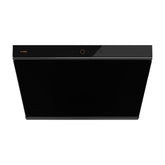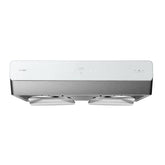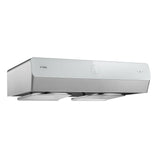How Many Amps Does A Dishwasher Use? A Homeowner’s Guide
Last Updated: 5/1/2025
Author: James Zhao, Sr. Tech Specialist & Alex Park, Product Specialist
There’s nothing more frustrating than running your dishwasher only to have the lights flicker and the circuit breaker trip halfway through the cycle. If it feels like your kitchen appliances are battling your electrical panel, you might be asking: how many amps does a dishwasher use?
In this guide, we’ll break down everything you need to know about dishwasher amperage, including how electrical usage varies by model, what a safe setup looks like, and how to avoid overloading your home’s electrical system. Whether you’re replacing an old unit or installing one for the first time, we’ll help you upgrade your kitchen safely and efficiently.
If you're looking to upgrade your kitchen, FOTILE's compact dishwashers combine high-temp sanitization, energy efficiency, and produce-washing tech in space-saving, ergonomic designs. Explore our full collection of dishwashers to find the perfect fit for your kitchen.
Understanding Electrical Terminology — What is an Amp?
An amp (short for ampere) measures the flow of electrical current. It indicates how much electricity is moving through a circuit at any given time. The amp rating of a dishwasher reveals how much current it draws during operation, which is important for understanding your kitchen's electrical load and preventing overloads.
How Many Amps Does a Dishwasher Use?
Most dishwashers use between 10 and 15 amps, depending on their design and settings. However, not all models are created equal. Here's a quick breakdown:
- Standard built-in dishwashers: Usually draw around 10–12 amps
- High-end or large-capacity models: May use up to 15 amps, especially during drying or high-heat sanitizing cycles
- Compact or energy-efficient units (like FOTILE models): Often use under 12 amps, ideal for homes with limited electrical capacity
Always check the specification label or manual for your dishwasher’s exact amperage. Exceeding the recommended amp draw can trip your breaker, damage the appliance, or pose a fire risk.
Dishwasher Circuit Requirements
To keep your dishwasher running safely, it’s important to understand its electrical circuit requirements. Dishwashers draw a decent amount of power, and overloading a shared circuit can lead to frequent breaker trips—or worse. Here’s what you need to know:
- Dedicated Circuit Recommended: Dishwashers should be installed on a dedicated 15-amp circuit, meaning no other appliances share the line. This ensures reliable performance and minimizes the risk of tripping the breaker.
- Voltage Needs: Dishwashers typically run on 120 volts, which is standard in most U.S. homes.
- Wire Gauge: Use 14-gauge wire for 15-amp circuits. If upgrading to a 20-amp breaker, 12-gauge wire is required to handle the higher current safely.
- Breaker Type: A standard single-pole circuit breaker is commonly used for dishwashers, but many local electrical codes now require a GFCI (Ground Fault Circuit Interrupter) or AFCI (Arc Fault Circuit Interrupter) breaker for added protection.
- Hardwired vs. Plug-In: Some dishwashers are hardwired directly into the electrical system, while others plug into an outlet. Always follow the manufacturer’s installation guide to ensure the connection method is supported.
Factors That Affect Amp Usage
Not all dishwashers draw the same amount of power. Several factors influence how many amps your dishwasher uses:
- Dishwasher Size: Larger models with higher capacity typically require more power.
- Wash Cycle Settings: Heavy-duty, steam-cleaning, and high-heat cycles draw more amps than eco or quick wash cycles.
- Drying Method: Heated drying elements draw more electricity than air-dry or convection drying systems.
- Water Temperature: If the dishwasher heats its own water, it will use more power than units that rely on pre-heated water from the home.
- Smart Features: Touchscreens, internal sensors, and Wi-Fi connectivity can slightly increase power demands.
- Age of Appliance: Older dishwashers tend to be less energy efficient and may use more amps than newer ENERGY STAR® certified models.
Dishwasher Installation Best Practices
Proper installation is crucial to ensuring the best performance from your dishwasher—and to keeping your home’s electrical system safe. Follow these practices to ensure a smooth, code-compliant setup:
- Use a Dedicated Circuit: Avoid sharing the circuit with other appliances to reduce the risk of overload.
- Follow Instructions Closely: Refer to your dishwasher’s manual for proper wiring, clearances, and electrical needs.
- Hire a Licensed Electrician: If you're unsure about wiring or breaker requirements, a professional can ensure a code-compliant setup.
- Check Local Electrical Codes: Many areas now require GFCI or AFCI protection for kitchen appliances—check before installing.
- Ensure Proper Grounding: Prevent shocks and improve safety with well-grounded connections.
- Allow for Ventilation: Leave enough space around the unit to prevent overheating and improve drying performance.
- Secure the Unit: Properly anchor the dishwasher, especially if installed under the counter, to prevent shifting during operation.
Safety Considerations For Dishwasher Amp Usage
Using the correct amperage for your dishwasher isn’t just about performance—it’s a safety must. Ignoring electrical limits can lead to tripped breakers, damaged appliances, or even electrical fires.
Keep these safety considerations in mind:
- Never Exceed Circuit Capacity: Make sure your dishwasher’s amp draw matches the circuit’s capacity and your breaker rating.
- Use GFCI or AFCI Protection: These circuit breakers reduce the risk of shock and fire and are increasingly required by local codes.
- Inspect Wiring: Outdated or improperly sized wiring can overheat and pose serious hazards.
- Check Outlet Conditions: For plug-in models, ensure outlets are grounded, in good condition, and rated for the electrical load.
- Avoid Extension Cords: Dishwashers draw consistent power and must be connected to a permanent, properly rated power source.
- Prevent Water Damage: Keep all electrical components dry during installation and maintenance.
- Schedule Periodic Inspections: Especially in older homes, have a licensed electrician evaluate your kitchen wiring every few years.
Dishwasher Amp Usage FAQs
Can I plug a dishwasher into a regular outlet?
Some models can plug into a standard 120V outlet, but the outlet must be rated for the correct amperage and GFCI-protected. For built-in units, hardwiring is often a better option for durability and safety.
Is 15 amps enough for a dishwasher?
Yes, many dishwashers—including compact and energy-efficient models like those from FOTILE—operate safely on a 15-amp circuit. However, if your dishwasher includes high-heat drying, smart features, or runs alongside other kitchen appliances, you may need a 20-amp circuit for added capacity.
Do I need a dedicated circuit?
A dedicated circuit is strongly recommended to prevent overload and protect your appliance and your home’s wiring. Sharing the circuit with other kitchen devices can trip the breaker or create long-term wear on your system.
What size breaker should I use?
For most standard dishwashers, a 15-amp breaker is sufficient. If your unit draws closer to 15 amps at peak usage, a 20-amp breaker may be more appropriate—but only if your wiring supports it. Always match the breaker to both the dishwasher’s specs and the wire gauge used.
Is GFCI required?
Yes. In most U.S. jurisdictions, GFCI protection is mandatory for kitchen appliances like dishwashers. This safety feature shuts off power when it detects ground faults, preventing electric shock. AFCI protection may also be required in some areas.
Upgrade Your Small Kitchen with a Compact, Powerful Fotile Dishwasher
FOTILE dishwashers are thoughtfully engineered for modern living—offering powerful cleaning performance, low amp draw, and space-saving design. Whether you live in an apartment, condo, or small home, our ENERGY STAR®-rated dishwashers maximize efficiency without overloading your electrical system.
Explore our full collection of innovative dishwashers to find the right model for your home.
- Choosing a selection results in a full page refresh.






